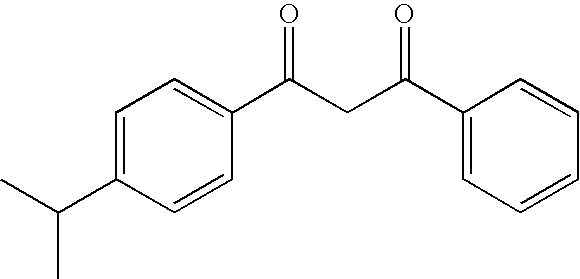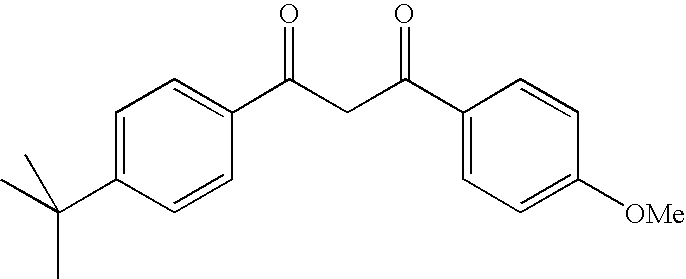Photoprotective compositions comprising photosensitive 1,3,5-triazine compounds, dibenzoylmethane compounds and siliceous s-triazines substituted with two aminobenzoate or aminobenzamide groups
a technology of dibenzoylmethane and dibenzoylmethane, which is applied in the direction of drug compositions, toilet preparations, dermatological disorders, etc., can solve the problems of skin browning, adverse changes, skin elasticity loss, etc., and achieve the effect of improving the stability of uv radiation (photostability) and improving the photostability
- Summary
- Abstract
- Description
- Claims
- Application Information
AI Technical Summary
Benefits of technology
Problems solved by technology
Method used
Image
Examples
examples of synthesis
Example 1
Preparation of 2,4-bis(ethyl 4′-diylaminobenzoate)-6-{[1,3,3,3-tetramethyl-1-[(trimethylsilyl)oxy]disiloxanyl]propyl-3-ylamino}-s-triazine
[0280]
First Step: Preparation of 2,4-dichloro-6-{[1,3,3,3-tetramethyl-1-[(trimethylsilyl)oxy]disiloxanyl]propyl-3-ylamino}-s-triazine
[0281]1-Amino-3-[1,3,3,3-tetramethyl-1-[(trimethylsilyl)oxy]disiloxanyl]propane (41.7 g, 0.149 mol) and a solution of sodium bicarbonate (11.4 g, 0.135 mol) in 120 ml of water are added dropwise at 0° C. to a solution of cyanuric chloride (25 g, 0.135 mol) in 250 ml of acetone, such that the pH is from 3 and 6.5. At the end of the addition, the pH is 6.5. The mixture is then stirred for 1 hour 30 minutes at 10° C. and then left at the temperature of the laboratory. The precipitate formed is filtered off, washed with water, suction-drained and dried. 55.2 g (yield: 95%) of the expected derivative are obtained in the form of a white powder (m.p.: 59° C.).
Second Step: Preparation of the Derivative of Example 1 ...
example 2
Preparation of 2,4-bis(n-butyl 4′-diylaminobenzoate)-6-{[1,3,3,3-tetramethyl-1-[(trimethylsilyl)oxy]disiloxanyl]propyl-3-ylamino}-s-triazine
[0285]
[0286]A mixture of the product from the first step of Example 1 (16.74 g, 0.0391 mol), n-butyl para-aminobenzoate (15 g, 0.0776 mol) and potassium carbonate (5.36 g, 0.0388 mol) is suspended in 170 ml of toluene and is refluxed for 1 hour 20 minutes, under a nitrogen sparge. The reaction mixture is cooled and 150 ml of dichloromethane are added. The mineral products are filtered off. The filtrate is washed with aqueous bicarbonate solution and then twice with water. After drying the organic phase and evaporating off the solvents, a white powder is obtained. After recrystallization from a 1 / 15 EtOAc / heptane mixture, 20.1 g (yield: 69%) of the derivative of Example 2 are obtained in the form of a white powder:
[0287]m.p.: 111-113° C.,
[0288]UV (ethanol): λmax=312 nm, E1%=1055.
example 3
Preparation of 2,4-bis(n-pentyl 4′-diylaminobenzoate)-6-{[1,3,3,3-tetramethyl-1-[(trimethylsilyl)oxy]disiloxanyl]propyl-3-ylamino}-s-triazine
[0289]
[0290]A mixture of the product from the first step of Example 1 (1 g, 2.3×10−3 mol), n-pentyl para-aminobenzoate (0.97 g, 4.6×10−3 mol) and sodium bicarbonate (0.39 g, 4.6×10−3 mol) in 15 ml of toluene is heated for 20 minutes at a temperature of 115° C. and at a power of 150 watts in a CEM Discover microwave reactor. Dichloromethane is added and the reaction mixture is washed with saturated sodium chloride solution and then twice with water. After drying the organic phase and evaporating off the solvents, a transparent oil is obtained. After purification on a column of silica (eluent: 85 / 15 heptane / EtOAc), the clean fractions of the derivative of Example 3 (0.9 g, yield: 50%) are obtained in the form of a white powder:
[0291]UV (ethanol): λmax=312 nm, E1%=1008.
PUM
| Property | Measurement | Unit |
|---|---|---|
| wavelengths | aaaaa | aaaaa |
| wavelengths | aaaaa | aaaaa |
| wavelengths | aaaaa | aaaaa |
Abstract
Description
Claims
Application Information
 Login to View More
Login to View More - R&D
- Intellectual Property
- Life Sciences
- Materials
- Tech Scout
- Unparalleled Data Quality
- Higher Quality Content
- 60% Fewer Hallucinations
Browse by: Latest US Patents, China's latest patents, Technical Efficacy Thesaurus, Application Domain, Technology Topic, Popular Technical Reports.
© 2025 PatSnap. All rights reserved.Legal|Privacy policy|Modern Slavery Act Transparency Statement|Sitemap|About US| Contact US: help@patsnap.com



